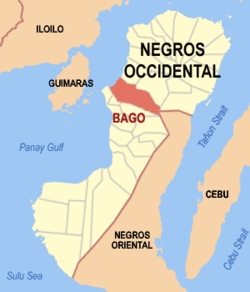Bago, Negros Occidental
| Bago | |||||||
|---|---|---|---|---|---|---|---|
| Component City | |||||||
| City of Bago | |||||||
From top, left to right: Public Plaza, Museum, Buenos Aires Mountain Resort, Tan Juan Monument, Kipot Twin Falls.
|
|||||||
|
|||||||
Nickname(s):
|
|||||||
 Map of Negros Occidental with Bago highlighted |
|||||||
| Location within the Philippines | |||||||
| Coordinates: 10°32′N 122°50′E / 10.533°N 122.833°ECoordinates: 10°32′N 122°50′E / 10.533°N 122.833°E | |||||||
| Country |
|
||||||
| Region | Negros Island Region (NIR/Region XVIII) | ||||||
| Province | Negros Occidental | ||||||
| District | 4th District of Negros Occidental | ||||||
| Founded | June 24, 1575 | ||||||
| Cityhood | February 19, 1966 | ||||||
| Barangays | 24 | ||||||
| Government | |||||||
| • Mayor | Nicholas M. Yulo | ||||||
| • Vice Mayor | Ramon D. Torres | ||||||
| Area | |||||||
| • Total | 401.20 km2 (154.90 sq mi) | ||||||
| Elevation | 0 m (0 ft) | ||||||
| Population (2010) | |||||||
| • Total | 170,981 | ||||||
| • Density | 430/km2 (1,100/sq mi) | ||||||
| Demonym(s) |
|
||||||
| Time zone | PHT (UTC+8) | ||||||
| ZIP code | 6101 | ||||||
| IDD : area code | (+64) 34 | ||||||
| Income class | 2nd class city | ||||||
| Website | www |
||||||
Bago, officially City of Bago (Hiligaynon: Dakbanwa/Syudad sang Bago; Filipino: Lungsod ng Bago) or simply Bago City, is a second class component city in the province of Negros Occidental of Negros Island Region in the Philippines, some 21 kilometres (13 mi) south of the provincial capital Bacolod. With a total of 170,981 people based on the 2015 census, Bago City comprises the 6.63% of the population of the entire Negros Occidental, making it the third most populous city in the province. It sets a land area of 389 square kilometres, which is 5% of the entire Negros Occidental and 10% of the total land area of component cities.
It is also tagged as the “Home of Historical and Natural Treasures”, owing to its contribution in the colourful history of the province of Negros Occidental and country, and its beautiful scenery and abundance in flora and fauna making it a good eco-tourism destination as well as the “Boxing Capital of the Philippines” title, owing to the great names it produced in boxing.
The community was named after a large tree called “Bágo” (gnetum gnemon) under which a native prince Mapagic died according to the writings of a Spanish historian, Diego de Povedano. Another version, however, noted that the name came from the shrub, bago-bago that grew abundantly in the riverbanks. Around the 17th and 18th Centuries, settlers from Molo, Iloilo formed a little village at the mouth of Bago River, presently a rich source of sand and gravel. The village grew into a large settlement prompting its elders to pass a petition for its conversion into a town or pueblo, which was granted in 1800.
Its history has its beginning on September 6, 1571 when the Spanish Adelantado, Miguel Lopez de Legaspi, allotted the community to a Spaniard named Juan Gutierrez Cortes as his "encomienda". At that time, the community was still composed of small clusters of settlements along the banks of a big river which later became known as the Bago River. The "encomiendero", since then, administered to the spiritual and socio-economic needs of the natives in the settlements until June, 1578; however, a year before that, this community was placed under the evangelical visitations of Father Geronimo Marin, an Augustinian priest who had taken charge of the Christianization of the natives of Binalbagan since the year 1572. Father Matin, upon his arrival in the community, celebrated the feast of St. John the Baptist, who would later be accepted as the patron saint of the place. Following the traditions and practices of the Spanish missionaries and historians in recording the founding of a "pueblo" or town that usually coincides with the feast day of a saint and since the feast day of St. John the Baptist, falls on June 24 of each year, it follows thereof that Bago was founded on June 24, 1575. History only records 1575 as the year when Bago was founded so that the exact month and day can only be deduced from such traditional practices of the Spaniards. Manila, Cebu and Binalbagan also predicted the dates of their founding on the same historical situations; hence, the logical conclusion is that Bago City was officially founded on the month, day and year heretofore mentioned.
...
Wikipedia








